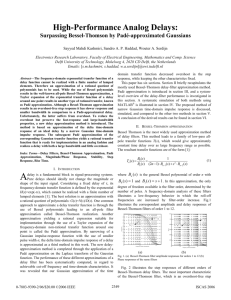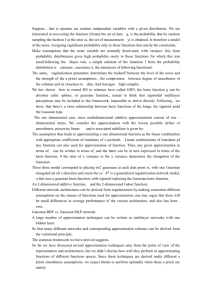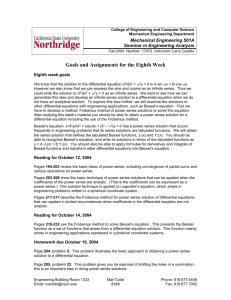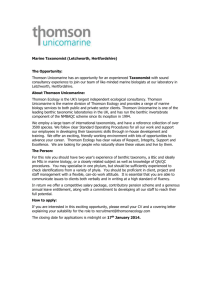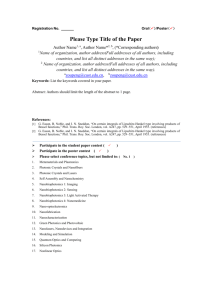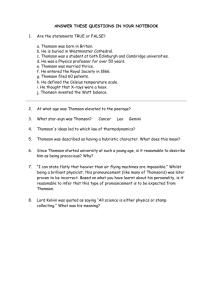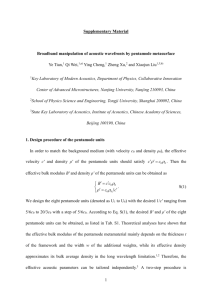Systematic Performance Comparison of Bessel Thomson
advertisement
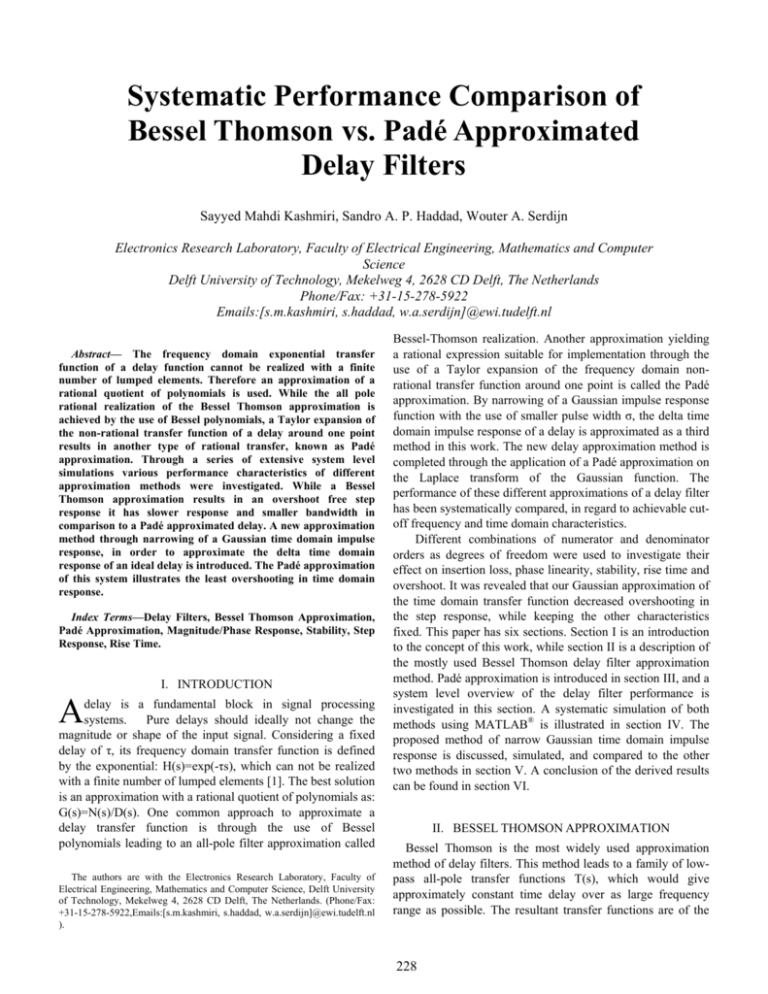
Systematic Performance Comparison of Bessel Thomson vs. Padé Approximated Delay Filters Sayyed Mahdi Kashmiri, Sandro A. P. Haddad, Wouter A. Serdijn Electronics Research Laboratory, Faculty of Electrical Engineering, Mathematics and Computer Science Delft University of Technology, Mekelweg 4, 2628 CD Delft, The Netherlands Phone/Fax: +31-15-278-5922 Emails:[s.m.kashmiri, s.haddad, w.a.serdijn]@ewi.tudelft.nl Abstract— The frequency domain exponential transfer function of a delay function cannot be realized with a finite number of lumped elements. Therefore an approximation of a rational quotient of polynomials is used. While the all pole rational realization of the Bessel Thomson approximation is achieved by the use of Bessel polynomials, a Taylor expansion of the non-rational transfer function of a delay around one point results in another type of rational transfer, known as Padé approximation. Through a series of extensive system level simulations various performance characteristics of different approximation methods were investigated. While a Bessel Thomson approximation results in an overshoot free step response it has slower response and smaller bandwidth in comparison to a Padé approximated delay. A new approximation method through narrowing of a Gaussian time domain impulse response, in order to approximate the delta time domain response of an ideal delay is introduced. The Padé approximation of this system illustrates the least overshooting in time domain response. Index Terms—Delay Filters, Bessel Thomson Approximation, Padé Approximation, Magnitude/Phase Response, Stability, Step Response, Rise Time. A I. INTRODUCTION delay is a fundamental block in signal processing systems. Pure delays should ideally not change the magnitude or shape of the input signal. Considering a fixed delay of τ, its frequency domain transfer function is defined by the exponential: H(s)=exp(-τs), which can not be realized with a finite number of lumped elements [1]. The best solution is an approximation with a rational quotient of polynomials as: G(s)=N(s)/D(s). One common approach to approximate a delay transfer function is through the use of Bessel polynomials leading to an all-pole filter approximation called The authors are with the Electronics Research Laboratory, Faculty of Electrical Engineering, Mathematics and Computer Science, Delft University of Technology, Mekelweg 4, 2628 CD Delft, The Netherlands. (Phone/Fax: +31-15-278-5922,Emails:[s.m.kashmiri, s.haddad, w.a.serdijn]@ewi.tudelft.nl ). Bessel-Thomson realization. Another approximation yielding a rational expression suitable for implementation through the use of a Taylor expansion of the frequency domain nonrational transfer function around one point is called the Padé approximation. By narrowing of a Gaussian impulse response function with the use of smaller pulse width σ, the delta time domain impulse response of a delay is approximated as a third method in this work. The new delay approximation method is completed through the application of a Padé approximation on the Laplace transform of the Gaussian function. The performance of these different approximations of a delay filter has been systematically compared, in regard to achievable cutoff frequency and time domain characteristics. Different combinations of numerator and denominator orders as degrees of freedom were used to investigate their effect on insertion loss, phase linearity, stability, rise time and overshoot. It was revealed that our Gaussian approximation of the time domain transfer function decreased overshooting in the step response, while keeping the other characteristics fixed. This paper has six sections. Section I is an introduction to the concept of this work, while section II is a description of the mostly used Bessel Thomson delay filter approximation method. Padé approximation is introduced in section III, and a system level overview of the delay filter performance is investigated in this section. A systematic simulation of both methods using MATLAB® is illustrated in section IV. The proposed method of narrow Gaussian time domain impulse response is discussed, simulated, and compared to the other two methods in section V. A conclusion of the derived results can be found in section VI. II. BESSEL THOMSON APPROXIMATION Bessel Thomson is the most widely used approximation method of delay filters. This method leads to a family of lowpass all-pole transfer functions T(s), which would give approximately constant time delay over as large frequency range as possible. The resultant transfer functions are of the 228 form: Tn ( s ) = III. PADE APPROXIMATION Bn (0) Bn ( s ) (1) Where, Bn(s) is a Bessel polynomial of order n. In this approximation the degree of freedom available is the filter order, determined by the number of poles. A frequency domain analysis of these filters illustrates a low frequency behavior in which the roll-off frequencies are increased by filter order increase. Fig. 1 illustrates the correspondent amplitude and delay response of Bessel Thomson filters of order 1 to 12. The amplitude of Bessel Thomson Filters of orders 1 to 12 0 10 -2 N=1 10 N=2 -4 10 N=3 N=4 -6 Amplitude 10 N=5 N=6 -8 10 N=7 N=9 N=10 N=11 N=12 -12 10 -1 0 10 1 10 2 10 (2) Where Pm(x) and Qn(x) are two polynomials as below: Pm ( s ) = p 0 + p1 s + p 2 s 2 + ... + p m s m (3) 2 n Q n ( s ) = q 0 + q1 s + q 2 s + ... + q n s The unknown coefficients p0 ... pm and q0 ... qn of Rm,n(s) can be determined from the condition that the first (m+n+1) terms vanish in the Maclaurin series: (4) Substituting the two polynomials into this expression and equating the coefficients leads to a system of m+n+1 linear homogeneous equations, which can be expressed in matrix form. -14 10 P (s) Rm , n ( s ) = m Qn (s) P (s) A( s ) − m =0 Qn ( s) N=8 -10 10 Padé approximation is a method of approximating a rational transfer function by expanding a function as a ratio of two power series [2]. The Padé approximation of order (m,n) for a function A(s) is defined to be a rational function Rm,n(s) expressed in a fractional form: 10 Frequency rad/Sec (Normalized) (a) The phase of Bessel Thomson Filters of orders 1 to 12 0.012 The amplitude of Pade Approximated Delay Filters 1 10 0.01 0 m=4, n=4 10 0.006 0.004 Amplitude Phase (Degrees) 0.008 N=12 m=4, n=5 m=4, n=6 N=11 N=10 N=9 N=8 N=7 N=6 N=5 N=4 N=3 N=2 N=1 0.002 0 0 2 4 6 8 10 Frequency rad/Sec (Normalized) 12 14 -1 m=4, n=7 10 m=4, n=8 m=4, n=9 16 -2 10 (b) 0 5 10 15 Frequency rad/Sec (Normalized) Fig. 1. (a) Bessel Thomson filter amplitude responses for orders 1 to 12 (b) Phase response of the same filters Fig.3. Amplitude response of Padé approximated delay filters with m=4 and n= 4..9 Fig. 2 illustrates the step response of different orders of Bessel Thomson delay filters. The most important characteristic of the Bessel Thomson filter, which is an over shoot free step response, in addition to the resultant decrease of rise time due to filter order increase can also be viewed here. Fig. 3 illustrates that in a Padé approximated delay filter, for an increase of denominator order the 3-dB cut off frequency of amplitude response increases, while peaking occurs for increase of order difference between numerator and denominator. A delay response simulation of Padé approximated delay filters for different order differences between numerator and denominator order (n-m), while increasing the denominator order (n), from 5 to 12 is illustrated in Fig. 4. This figure illustrates that for higher orders of denominator order, higher delay roll-off frequency is achieved, while the peaking effect near the roll-off frequency increases for higher numerator and denominator order differences. More accurate delay response is achieved for smaller order difference and higher denominator order. Step Response 1.4 1.2 1 Amplitude 0.8 N=1 N=2 0.6 N=3 N=4 N=5 N=6 0.4 N=7 N=8 N=9 N=10 N=11 N=12 0.2 0 0 0.5 1 1.5 2 2.5 3 3.5 Time (sec) Fig. 2. Step response of different order Bessel Thomson filters. 229 The rise time of Pade Approximated delay filters The Delay of Pade Approximated Delay Filters 0.35 0.02 n-m=4 n=m+3 Increase of Order 0.018 n=m+2 n-m=3 n=5 ~ n=12 n=m+1 0.3 n-m=2 0.016 n-m=1 n-m=0 rise time (Seconds) 0.014 Delay 0.012 0.01 0.25 0.2 0.008 0.15 0.006 0.004 0.1 0.002 0 0 5 10 15 Frequency rad/Sec (Normalized) 20 25 30 Fig.4. Delay response of Pade approximated delay for different order difference and different denominator order. A series of time domain simulations on the step response of Padé approximated delay filters illustrates that the rise time decreases with the increase of the denominator order (Fig. 5), while zero time oscillations are generated when the order difference between the denominator and numerator decreases (Fig. 6). These zero time oscillations are not favorable and might cause instability in some applications. Step Response 1.2 1 0.8 4 5 6 7 8 m (numinator order) 9 10 11 12 Fig.7. Rise time comparison for different combinations of numerator and denominator orders. An investigation of the pole zero constellations for different order combinations of Padé approximated delay filters illustrated that the increase of the numerator and denominator order above a specific level would lead to instability in high order delay filters. Table I illustrates the unstable order combinations in bold. TABLE I STABLE AND UNSTABLE ORDER COMBINATIONS 1/12 1/11 1/10 1/9 1/8 1/7 1/6 1/5 1/4 1/3 1/2 1/1 2/12 2/11 2/10 2/9 2/8 2/7 2/6 2/5 2/4 2/3 2/2 3/12 3/11 3/10 3/9 3/8 3/7 3/6 3/5 3/4 3/3 4/12 4/11 4/10 4/9 4/8 4/7 4/6 4/5 4/4 512 5/11 5/10 5/9 5/8 5/7 5/6 5/5 6/12 6/11 6/10 6/9 6/8 6/7 6/6 7/12 7/11 7/10 7/9 7/8 7/7 8/12 8/11 8/10 8/9 8/8 9/12 9/11 9/10 9/9 10/12 10/11 10/10 11/12 11/11 12/12 Num/Denom Unstable Stable 0.6 Amplitude m=2,n=5 IV. COMPARISON OF BESSEL THOMSON AND PADÉ m=3,n=6 m=4,n=7 0.4 m=5,n=8 APPROXIMATED DELAY FILTERS m=6,n=9 m=7,n=10 0.2 0 -0.2 0 0.5 1 1.5 2 2.5 3 3.5 4 Time (sec) Fig.5. Rise time decrease with filter order increase Step Response 1.2 1 0.8 In this section a comparison of the frequency domain and time domain performance metrics of Bessel Thomson and Padé approximated delay filters are illustrated. According to amplitude and delay responses sketched for different order combinations of Bessel Thomson and Padé delay filters, in Fig. 8 and Fig.9 respectively, the lower orders of Padé approximation can always achieve higher frequencies than the highest reasonable Bessel Thomson approximations. m=5,n=10 0.6 Comparison of The amplitude of Pade Delay Filters and Bessel Thomson Delay Filters Amplitude m=6,n=10 1.4 m=7,n=10 0.4 m=8,n=10 m=9,n=10 1.2 Bessel Thomson 12 m=10,n=10 0.2 Pade 2/4 1 0 0.8 Pade 10/12 Amplitude -0.2 0.6 -0.4 0 0.5 1 1.5 2 2.5 3 3.5 4 Time (sec) 0.4 Fig.6. Increase of zero time oscillations with the decrease of denominator and numerator order difference. 0.2 Bessel Thomson 4 0 Fig. 7 illustrates that the filter order increase results in a faster step response while filters with larger numerator and denominator order difference provide smaller rise times. 0 5 10 15 Frequency rad/Sec (Normalized) 20 25 30 Fig.8. Amplitude comparison of Bessel Thomson delay filters of orders 4 to 12 vs. Padé approximated delay filters of order 2/4 to 10/12. 230 The Delay of Pade 6/8 Approximated Delay vs. 8th Order Bessel Thomson 40 0.012 Pade 4/6 35 0.01 Sigma=0.01 Pade 10/12 30 Mean = 1 0.008 Delay 25 20 0.006 15 0.004 10 Bessel Thomson 4 Sigma=0.1 0.002 5 Bessel Thomson 12 0 0 5 10 15 Frequency rad/Sec (Normalized) 20 25 Fig.9. Delay comparison of Bessel Thomson delay filters of orders 4 to 12 vs. Pade approximated delay filters of order 4/6 to 10/12. A comparison of step response of both approximations (Fig. 9) illustrates that Padé approximated delay filters always introduce more overshoot and oscillations in comparison to Bessel Thomson counterparts, while the former has smaller rise times (Fig. 10). Step Response 1.2 1 Pade 6/8 0.8 0 0.6 30 Bessel 8 Amplitude 0.6 0.4 0.7 0.8 0.9 1 1.1 1.2 1.3 Fig.11. A Gaussian function’s response vs. the change of σ 1 e σ 2π h (t ) = − (t − µ ) 2 2σ 2 (5) In this method a Padé approximation is applied to the Laplace transform of a Gaussian impulse response. Figure 12 illustrates that the amplitude response of the Gaussian impulse response delay filter becomes more near to Bessel Thomson approximation for larger values of σ, decreasing the roll-off frequency, while Fig. 13 illustrates that the effect on the delay response is minimum. 0.2 Comparison of The amplitude of Pade Delay Filter of order 6/8 and a Bessel Thomson of order 8 1.4 0 1.2 -0.2 0 0.5 1 1.5 2 2.5 3 3.5 Pade of Delay order 8/10 4 Time (sec) 1 Pade of Gaussian order 8/10, sigma=0.01 Fig.9. Comparison of step response in both approximations Amplitude 0.8 The rise time of Pade Approximated delay filters 1.1 Pade of Gaussian order 8/10, sigma=0.1 0.6 Pade m,n=m+3 1 Pade m,n=m+2 Pade m,n=m+1 0.9 Bessel Thomson Order m 0.4 rise time (Seconds) 0.8 Bessel Thomson order 32 0.2 0.7 Bessel Thomson order 10 0.6 0 0 5 10 0.5 0.4 20 25 30 Fig.12. The amplitude response of the Gaussian impulse response delay vs. σ in comparison to normal Padé approximated delay and Bessel Thomson responses 0.3 0.2 0.1 15 Frequency rad/Sec (Normalized) 4 5 6 7 8 m (numinator order) 9 10 11 12 The Delay of Pade Approximated Delay vs. 8th Order Bessel Thomson, and Gaussian Pade Approximated 8/10 0.012 Fig.10. Rise time comparison Gaussian Pade 5/7 & sigma: 0.01~0.1 Gaussian Pade 8/10 & sigma: 0.01~0.1 0.01 In order to have the higher frequency and faster time domain response of Padé approximation, together with less overshoots as the Bessel Thomson approximation achieves, a new approximation method is introduced in the following section. Delay 0.008 Delay Pade 4/6 Delay Pade 10/12 0.006 0.004 Bessel Thomson 4 0.002 V. GAUSSIAN TIME DOMAIN IMPULSE RESPONSE METHODE Bessel Thomson 12 0 The time domain impulse response of a delay function is a delta function. A delta function can be approximated by narrowing of a Gaussian time domain transfer function with the use of smaller pulse width σ (depicted by equation 5, and Fig. 11). 0 5 10 15 Frequency rad/Sec (Normalized) 20 25 30 Fig.13. The delay response of the Gaussian impulse response delay vs. σ in comparison to normal Padé approximated delay and Bessel Thomson responses An investigation of the Gaussian impulse response delay approximation delay filter’s step response proves that the 231 increase of σ, making the impulse response wider, leads to a decrease of the zero time oscillations and overshoots, while it slightly increases the rise time (Fig. 14). As a result of these simulations it is revealed that using a time domain Gaussian impulse response gives the possibility of decreasing the overshoots and zero time ringings in a Padé approximation of delay by increasing σ, while the price paid is an increase of insertion loss in the amplitude response and a slightly slower rise time in the system step response. Fig.15 compares the step response of a 6/8 Padé approximated delay filter with the same order Gaussian impulse response delay filter with σ value equal to 0.05. As illustrated by this graph, for the same nominator and denominator order, the Gaussian impulse response delay has less overshooting. REFERENCES [1] [2] Rolf Schaumann, Mac Van Valkenburg, "Design of Analog Filters", Oxford University Press, ISBN: 0-19-511877-4 Haddad, S.A.P.; Verwaal, N.; Houben, R.; Serdijn, W.A,"Optimized dynamic translinear implementation of the Gaussian wavelet transform", IEEE International Symposium on Circuit and Systems, May 2004 Step Response 1.2 1 m=8 and n=8 0.8 sigma=0.01 sigma=0.02 0.6 Amplitude sigma=0.03 sigma=0.04 0.4 sigma=0.05 sigma=0.06 sigma=0.07 0.2 sigma=0.08 sigma=0.09 0 sigma=0.10 -0.2 -0.4 0 0.5 1 1.5 2 2.5 3 3.5 4 4.5 5 Time (sec) Fig.14. The step response of the Gaussian impulse response delay vs. σ 1.2 Pade approximation 1 Gaussian Impulse response approximation Sigma = 0.05 0.8 0.6 0.4 0.2 0 -0.2 0 0.5 1 1.5 2 2.5 3 3.5 4 4.5 5 Fig.15. The step response of the Gaussian impulse response delay for a value of σ = 0.05 and filter order of 6/8, vs. the same filter order Padé approximated delay filter VI. CONCLUSION While Bessel Thomson is the most widely used method of delay filter approximation, higher frequency, and faster delay responses can be achieved through the use of Padé approximation at the expense of more overshooting, while different order combinations would result in responses, with different stability conditions. The here introduced method of Gaussian time domain impulse response leads to less oscillation and overshooting, at the expense of slower rise time and lower roll off frequency in amplitude response compared to the previously mentioned methods. 232

